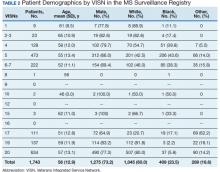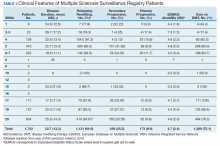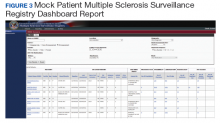The Multiple Sclerosis Surveillance Registry: A Novel Interactive Database Within the Veterans Health Administration
Objective: To demonstrate the infrastructure and utility of an interactive health system database for multiple sclerosis (MS), we present the MS Surveillance Registry (MSSR) within the US Department of Veterans Affairs (VA).
Background: Disease specific databases can be helpful in the management of neurologic conditions but few are fully integrated into the electronic health record and linked to health system data. Creating a consistent information technology (IT) architecture and with ongoing support within disease specific registries has been a challenge.
Methods: Building the MSSR was initiated by an iterative process with an IT team and MS health care providers. A common registry platform shared by other VA disease specific registries (eg, traumatic brain injury and cancer) was used to develop the IT infrastructure. MS cases were entered online into the MS Assessment Tool at selected MS Centers of Excellence (MSCoE) clinics in the US. Other large VA databases linked to MSSR are reviewed. Patient demographic and clinical characteristics were compared and contrasted with the broader VA population and other US registry populations.
Results: We have enrolled 1,743 patients with MS in the MSSR through fiscal year 2019 from selected MS regional programs in the VA MSCoE network. The mean age of patients was 56.0 years, with a 2.7 male:female ratio. Among those with definite MS, the mean European Database for MS Disability Score was 4.7 and 75% had ever used an MS disease modifying therapy. A summary electronic dashboard was developed for health care providers to easily access demographic and clinical data for individuals and groups of patients. Data on comorbid conditions, pharmacy and prosthetics utilization, outpatient clinic visits, and inpatient admission were documented for each patient.
Conclusions: The MSSR is a unique electronic database that has enhanced clinical management of MS and serves as a national source for clinical outcomes.
Results
After a live or remote telehealth or telephone visit, a clinician can access MSAT from the Computerized Patient Record System (CPRS) or directly from the MSSR online portal (Figure 1). The tool uses radio buttons and pull-down menus and takes about 5 to 15 minutes to complete with a list of required variables. Data is auto-saved for efficiency, and the key variables that are collected in MSAT are noted in Table 1. The MSAT subsequently creates a text integration utility progress note with health factors that is processed through an integration engine and eventually transmitted to VISTA and becomes part of the EHR and available to all health care providers involved in that patient’s care. Additionally, data from VA outpatient and inpatient utilization files, pharmacy, prosthetics, laboratory, and radiology databases are included in the CDW and are included in MSSR. With data from 1998 to the present, the MSAT and CDW databases can provide longitudinal data analysis.
Between 18,000 and 20,000 patients with MS are evaluated in the VHA annually, and 56,000 unique patients have been assessed since 1998. From 2016 to 2019, 1,743 patients with MS or related disorders were enrolled in MSSR (Table 2 and Figure 2). The mean (SD) age of patients was 56.0 (12.9) years and the male:female ratio was 2.7. Racial minorities make up 40% of the cohort. Among those with definite and possible MS, the mean disease duration was 22.7 years and the mean (SD) European Database for MS disability score was 4.7 (2.4) (Table 3). Three-quarters of the MSSR cohort have used ≥ 1 MS disease modifying therapy and 65% were classified as relapsing-remitting MS. An electronic dashboard was developed for health care providers to easily access demographic and clinical data for individuals and groups of patients (Figure 3). Standard and ad hoc reports can be generated from the MSSR. Larger longitudinal analyses can be performed with MSAT and clinical data from CDW. Data on comorbid conditions, pharmacy, radiology and prosthetics utilization, outpatient clinic and inpatient admission can be accessed for each patient or a group of patients.
In 2015, MSCoE published a larger national survey of the VA MS population.15 This study revealed that the majority of clinical features and demographics of the MSSR were not significantly different from other major US MS registries including the North American Research Committee on MS, the New York State MS Consortium, and the Sonya Slifka Study.16-18
Discussion
The MSSR is novel in that it combines a traditional MS registry with individual clinical and utilization data within the largest integrated health system in the US. This new registry leverages the existing databases related to cost of care, utilization, and pharmacy services to provide surveillance tools for longitudinal follow-up of the MS population within the VHA. Because the structure of the MSAT and MSSR were developed in a partnership between IT developers and clinicians, there has been mutual buy-in for those who use it and maintain it. This registry can be a test bed for standardized patient outcomes including the recently released MS Quality measures from the American Academy of Neurology.19











